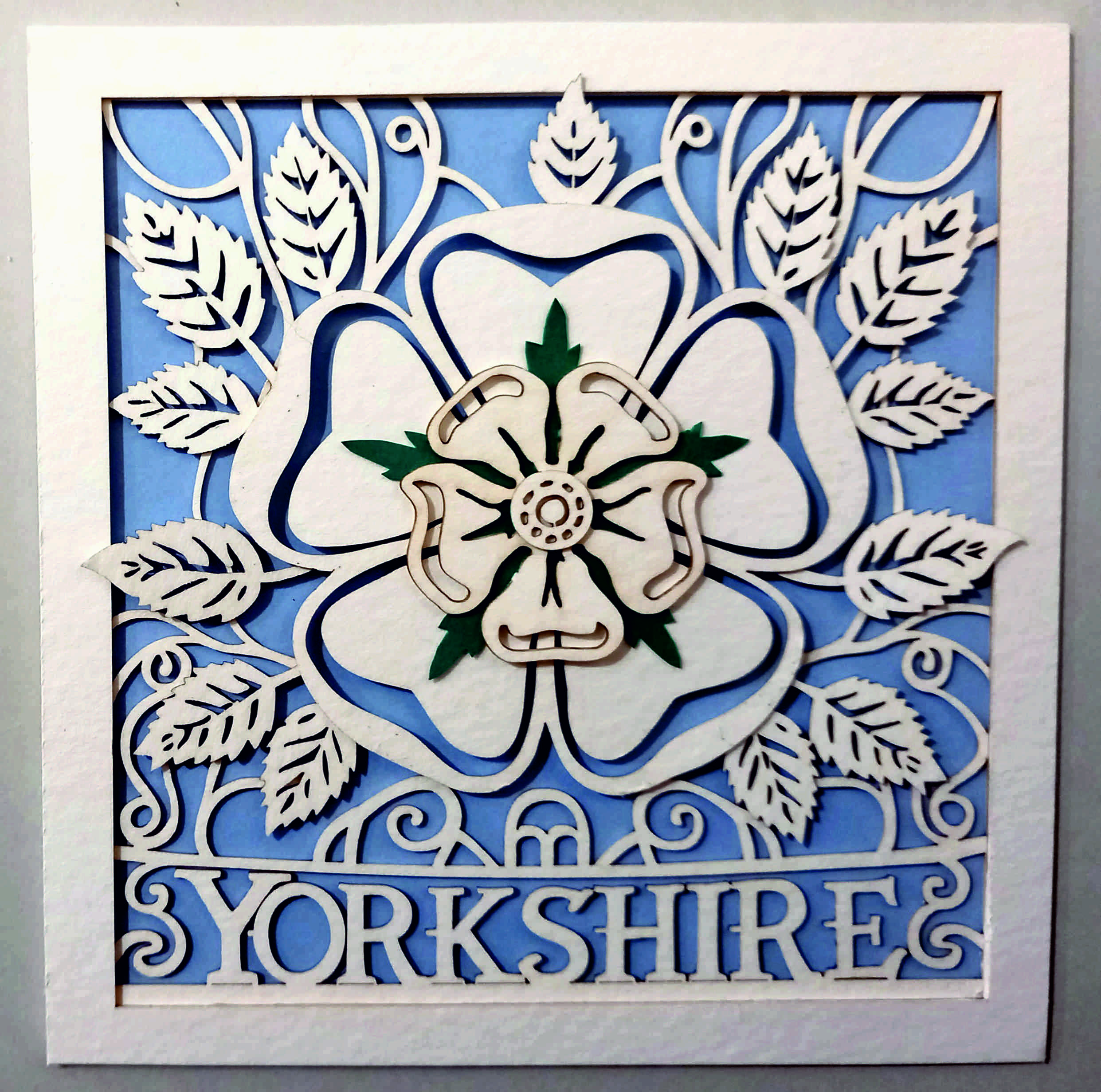
As mentioned previously, I’ve declared that one of my creative goals for 2024 is to create at least 52 AI assisted/inspired artworks this year, using AI-generated images as a prompt for actual physical creative pieces. My most recent piece is a Yorkshire Rose card.
Using ChatGPT’s DALL-E, I gave it a prompt:
Please try to create a papercut greetings card of a Yorkshire Rose.
This is what it came up with on the first attempt:
As usual, my first reaction was “WOW”. But then my follow-up reaction was the realisation that:
1) these designs wouldn’t be very easy to recreate as physical objects, and
2) they were just white roses, rather than actual Yorkshire roses.
…so I had to try to teach DALL-E what a Yorkshire Rose was:
Thanks – those are lovely but they are just white roses rather than specifically Yorkshire roses. The Yorkshire rose is a traditional emblem of Yorkshire in the UK. It is usually shown as having 5 white inner petals and 5 white outer petals – usually with leaves in between the 5 outer petals. It is similar to a Tudor rose, but with all-white petals instead of some petals being red.
Here are the results:
Now we were getting somewhere! For some reason I wanted to create a card that actually said “Yorkshire” on it. So I asked DALL-E to include “Yorkshire” under the rose emblem. This fifth attempt was OK, but again would have been difficult to directly create as a physical card…
…but the sixth attempt was excellent (with – of course – the exception being that DALL-E mis-spelled the only word I’d asked it to include):
Bingo! I instantly loved this design, but there was still a lot of work to do before I could cut it out:
- Obviously I needed to correct the spelling.
- Some areas wouldn’t work as papercuts because they weren’t attached to any other parts of the card, so I needed to adapt them.
- Because of the shadows in the image, I would need to create the image as several layers.
Creating the physical design
This time I opened the Linearity Curve image software, and drew lines around the elements of the design so I could create an SVG file to cut with my laser cutter. I cut it with the laser because I thought I might not be accurate enough if I did it by hand.
Here is the original image on the left, with my physical version of the card on the right:
How well did DALL-E follow my prompts?
As mentioned above, the AI image generator initially didn’t know what a Yorkshire Rose was. However, once I’d explained the concept it did an amazing job… although then it let itself down again by mis-spelling a specific word. The papercut element was great, though. So on the whole I’ll give DALL-E 8/10.
How close is the physical version to the original AI design?
I’m going to give myself 83%. The differences are:
- I changed “YORKSHHIRE” to “YORKSHIRE”
- I had to link some of the ‘orphaned’ design elements to other parts of the design so that they wouldn’t fall out when I cut them.
- I couldn’t get the shadows/lighting the same as in the original image. (Some of the shadows seem difficult/impossible to achieve in the physical version, so I didn’t make too much of an effort trying to get them exactly right.)
- To get the right-looking thickness of paper I had to use watercolour card rather than paper, but that’s got a bit more of a creamy colour than the bright paper of the original image.
- The laser made brown marks on the edges of the card, so again I haven’t been able to match the brightness of the original image.
Elements where I just left the AI design and didn’t make any changes:
- The shapes of the leaves and the rose.
- The shapes of the individual letters.
Lessons learned
- When making a layered papercut, even if the pieces have already been cut out by laser it can still take a long time to position the pieces correctly so they can be glued into place.
- (Solution to point (1) above:) If it’s tricky to position the layers of designs on top of each other, etch the positions onto the backs of the other paper pieces. For example, I etched the outline of the leafy piece onto the back of the large rose piece. This made it much quicker to accurately glue the leaves into place.
Things I still need to learn or improve
- Is there a quicker way to automatically (but accurately) convert the JPG image into SVG shapes? I tried to use Curve’s ‘Autotrace’ function, but it wasn’t very accurate so I decided to draw around most of the shapes by hand (using an Apple pencil).
- If I get chance later, I might try to match the shadows more accurately, and maybe also try to cut from a thinner, whiter paper or card.
Homework:
- Create a specific Barnsley version of the card/artwork.
- Create a version with no text.
- Try to cut from thinner, whiter paper/card.
Thanks for reading this post. If you’ve got any suggestions of prompts or projects – or if you’ve been experimenting yourself with AI-assisted images – I’d love to hear about them. You can either comment below or send me a message via the Contact form.